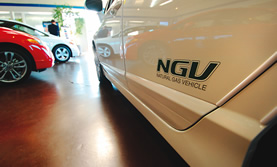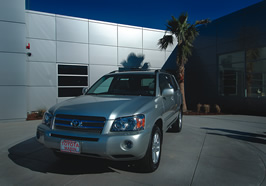Valerie Robin and her daughter Samantha own hybrids—those fuel-saving cars that run on electric as well as gasoline power. “I just love my Prius,” says Valerie Robin, office manager for the Ark newspaper in Tiburon. “It’s a hatchback and I can easily fit my bike in the back.”
That’s exactly what Samantha Robin didn’t want: the signature humpbacked Prius shape. “I didn’t like the bulky look,” says the 22-year-old, who works in Larkspur. “I wanted a car that looked like a regular car.” She bought a Honda Civic hybrid.
 As that mother-daughter difference shows, nowadays driving green is all about choice—especially in Marin, where high-level environmental consciousness and strict California emissions laws combine to give motorists more eco-friendly options than ever.
As that mother-daughter difference shows, nowadays driving green is all about choice—especially in Marin, where high-level environmental consciousness and strict California emissions laws combine to give motorists more eco-friendly options than ever.
“Californians are lucky,” says Jim Kliesch, a researcher with the American Council for an Energy-Efficient Economy, a Washington, D.C., nonprofit that champions everything green. Because California law requires automakers to sell a certain percentage of low-emission vehicles, says Kliesch, “more environmentally friendly models are available in California than anywhere else in the nation.”
Given the number of hybrids readily seen in any local shopping center, Marinites appear to be greener-minded than motorists anywhere else in the state. Case in point: in the last half of 2006 “over 19 percent of our sales were hybrids,” says David Shapiro, president and CEO of Cartelligent, a Sausalito auto brokerage that sells more than 200 cars of all types every month. By comparison, hybrids represent only 1.5 percent of car sales nationally, says Kliesch.
A Hybrid for Every Taste
 There are numerous classifications regarding the “greenness” of any given car, and it is easy to get lost in the jumble of acronyms. The California Air Resources Board labels the cleanest vehicles ZEV (zero emission vehicle), PZEV (partial zero emission vehicle) or ATPZEV (advanced technology partial zero emission vehicle). An increasing number of cars meet these standards, including many gas-powered vehicles that come close to hybrids for their great gas mileage on the highway.
There are numerous classifications regarding the “greenness” of any given car, and it is easy to get lost in the jumble of acronyms. The California Air Resources Board labels the cleanest vehicles ZEV (zero emission vehicle), PZEV (partial zero emission vehicle) or ATPZEV (advanced technology partial zero emission vehicle). An increasing number of cars meet these standards, including many gas-powered vehicles that come close to hybrids for their great gas mileage on the highway.
Hybrids, though, are not only stingy on emissions but also misers on gas. A hybrid uses its electric motor initially and in traffic, but the more you accelerate, the more the gas engine engages. When you’re cruising the highway, both the electric motor and gas engine are engaged. Often the two work in tandem. And regardless of manufacturer, a hybrid will emit fewer greenhouse gases while traveling farther on every gallon of gas consumed.
Beyond that fact is where debate about best hybrid begins.
“Nothing compares with the Prius,” says Jim Dahme, the in-house hybrid expert at Toyota Marin in San Rafael. Indeed, the Prius (meaning “to go before” in Latin) has impressive numbers: an EPA rating of 61 mpg for city driving and 51 mpg on the freeway. (Hybrids notoriously get better city mileage than highway because in town they run more on electric than on gas.) “It drives like a ‘performance car,’” Dahme adds, though he bobs and weaves a bit when asked to define that term.
 Dahme didn’t emphasize two additional figures the EPA now requires dealers to post on a new car’s window sticker: the vehicle’s smog emission index and its estimated annual fuel cost. Here again, the Prius does very well. On a scale of zero to three, with 0.4 being average for cars of similar size, the Prius has a smog emission index of only 0.09. Its estimated annual fuel cost, based on 15,000 miles at $2.75 a gallon, is a mere $723. (By comparison, a $77,500 Corvette has a smog index of 0.49 and fuel costs almost three times as high.)
Dahme didn’t emphasize two additional figures the EPA now requires dealers to post on a new car’s window sticker: the vehicle’s smog emission index and its estimated annual fuel cost. Here again, the Prius does very well. On a scale of zero to three, with 0.4 being average for cars of similar size, the Prius has a smog emission index of only 0.09. Its estimated annual fuel cost, based on 15,000 miles at $2.75 a gallon, is a mere $723. (By comparison, a $77,500 Corvette has a smog index of 0.49 and fuel costs almost three times as high.)
Not surprisingly, Keith Rey, general manager of Marin Honda in Corte Madera, doesn’t share Dahme’s lofty opinion of the Prius. “Honda is the greenest motor company in the world,” says Rey. Why then do you see more Priuses on local roads than Civic hybrids? “Toyota is a marketing company,” says Rey, “one of the world’s largest. Honda is a technical engineering company, the world’s finest.” A glance at a hybrid Civic’s window sticker bears him out: the Civic is rated at 49 mpg city and 51 mpg highway, with an estimated annual fuel cost of $795 and a smog emission index of 0.09 (same as the Prius).
Both the Prius and the Civic hybrid are considered partial zero emission vehicles (PZEVs) and are rated nearly identically by greenercars.com, the website run by energy researcher Kliesch’s group. But the Prius does win by a bumper: factoring in such criteria as emission, fuel costs and overall environmental impact, greenercars.com gives the Prius a “green score” of 55 to Honda’s 53. (The greenest car of all, however, is a Honda: the natural-gas-powered Civic GX— it got a 57.
Whatever the reason, Marin motorists appear to share Valerie Robin’s preference for the Prius: Mark McCollum, general manager of Toyota Marin, says his dealership sells about 45 Priuses a month, more than 500 a year. “There’s no question we lead the country in Prius sales,” he says. By comparison, Honda GM’s Rey sells about half that number of Civic hybrids—261 in 2006—even though a similarly equipped Civic sells for about $2,500 less than the Prius.
Midsize Cars and Compacts
While green driving started small with compacts like the hybrid Prius and Civic (and the now-out-of-production subcompact two-seat Honda Insight), it’s getting bigger. San Rafael marketing consultant Gary Tobin spent more than three months looking for a midsize hybrid. “I talked with dealers, friends, went online—the EPA website was excellent,” he says. “But nothing seemed right for my work until I Googled ‘environmentally friendly cars’ and discovered the 2007 Toyota Camry hybrid.”
Kliesch says Tobin made a wise choice. “There’s no doubt it will be on our 2007 list of greenest cars,” he says. “It gets 40 miles per gallon in the city, 38 on the highway, is a PZEV and will have a GreenerCars.com rating of ‘superior’ (the group’s highest).” With leather seats and a navigation system, the Camry hybrid sells in the low $30,000s.
There are less-expensive alternatives. The midsize Hyundai Elantra, while not a hybrid, is nearly as green as the Prius and Civic hybrid and costs about half as much. “I’m selling nearly ten of these a month,” says Phil Sachs, sales manager of San Rafael Chevrolet. The Elantra’s eco-credentials are impressive: 27 mpg city, 34 highway with a four-cylinder engine and manual transmission, a 0.21 smog index and estimated annual fuel costs of $1,220.
The Elantra’s more compact sibling the Accent is another green car that saves a buyer a bunch of green. It can sell for less than $10,000, says Sachs, and has an estimated mileage of 28 mpg city and 36 mpg highway, a smog index of 0.39 and approximate annual fuel cost of $1,284. Those numbers won the Accent a “superior” rating from GreenerCars.com.
Other “superior” nonhybrid cars—so rated for their three- or four-cylinder engines, high mileage and extremely clean-burning engines—include the subcompact Chevy Cobalt and the Ford Focus midsize wagon.
Green SUVs?
 Even the most environmentally minded families may have trouble fitting all their kids and gear inside a compact or even a midsize car. And while a green SUV may sound like an oxymoron, it isn’t. Three hybrid SUVs are now being sold in Marin: the Ford Escape, the Toyota Highlander and the Lexus RX 400h.
Even the most environmentally minded families may have trouble fitting all their kids and gear inside a compact or even a midsize car. And while a green SUV may sound like an oxymoron, it isn’t. Three hybrid SUVs are now being sold in Marin: the Ford Escape, the Toyota Highlander and the Lexus RX 400h.
“The Escape is the greenest SUV on the market,” says Logan Tuggle, sales manager of Ford of Marin in San Rafael. Enough with the sales pitch, let’s hear some numbers. Tuggle reels them off: city mileage of 32 mpg, highway as high as 34 mpg. A smog emission index of 0.09 and yearly fuel costs of about $1,100. The Escape hybrid, nicely equipped, sells for about $33,000.
For another $6,000, or more depending on add-ons, there’s the hybrid version of the Toyota Highlander. “I like this car,” says Dahme of Toyota Marin during a drive from downtown San Rafael up to Lucas Valley Road. He should: the Highlander hybrid is a fine-feeling, smooth-running SUV that ranks among the greenest of green vehicles. Compared to a non-hybrid Highlander, it averages at least 11 more miles to a gallon of gas, has a smog index of 0.09 vs. 0.4 and burns $730 less in gas annually.
The Lexus RX 400h is the priciest of the green SUVs, running $50,000 and up. Lexus of Marin salesman Bob Kaufman says a 400h with a V6 engine “emits nearly 70 percent fewer smog-forming emissions than a conventional SUV.” GreenerCars.com rates the 400h
“superior” based on its smog index of 0.09 and gas mileage of 33 mpg city and 28 mpg highway.
How green are Marin’s highways? Greener by the day.


